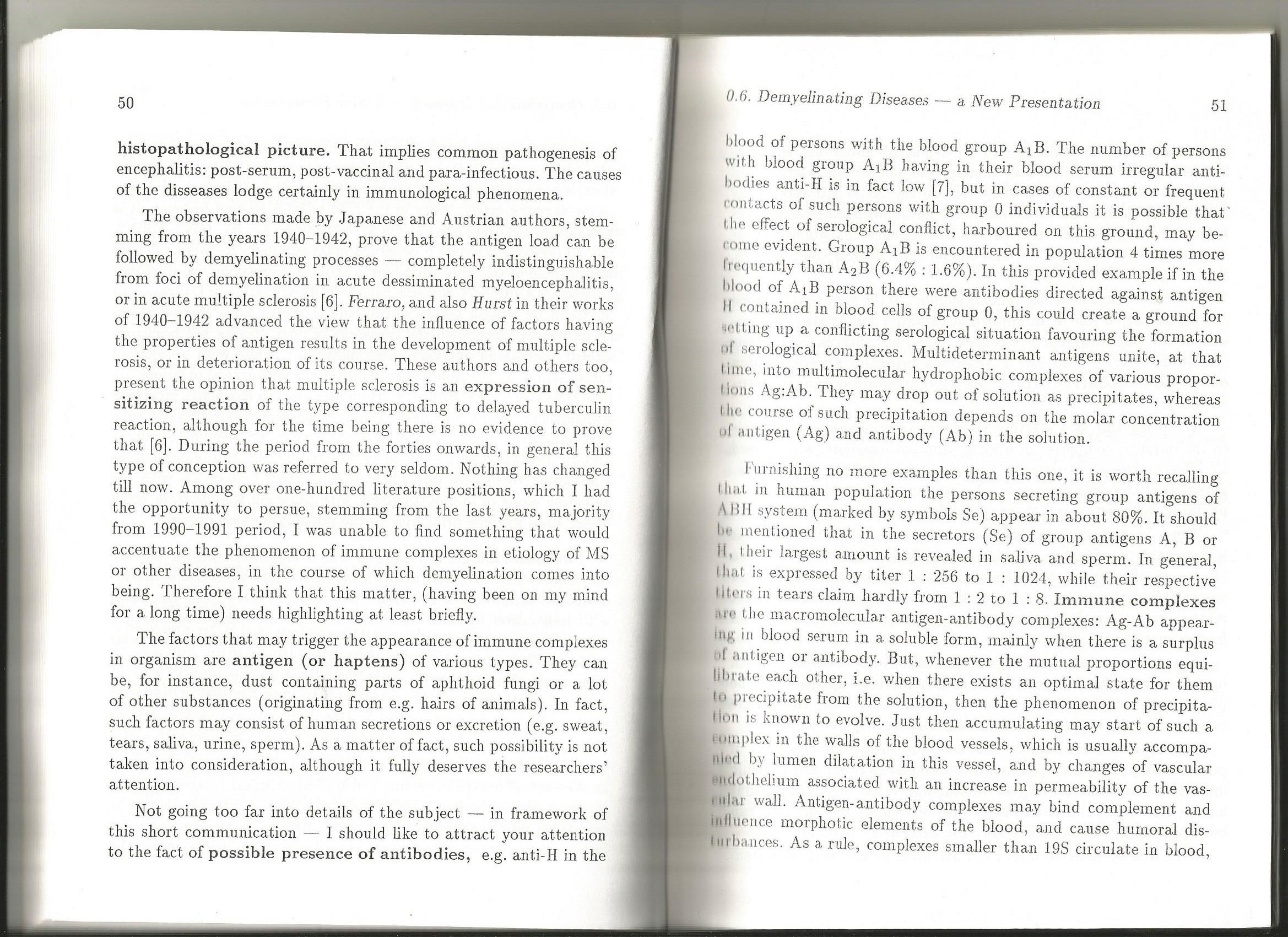89724 Scan0026 (16)

50
histopathological picture. That implies common pathogenesis of encephalitis: post-serum, post-vaccinal and para-infectious. The causes of the disseases lodge certainly in immunological phenomena.
The observations madę by Japanese and Austrian authors, stem-ming from the years 1940-1942, prove that the antigen load can be followed by demyelinating processes — completely indistinguishable from foci of demyelination in acute dessiminated myeloencephalitis, or in acute multiple sclerosis [6]. Ferraro, and also Hurst in their works of 1940-1942 advanced the view that the influence of factors having the properties of antigen results in the development of multiple sclerosis, or in deterioration of its course. These authors and others too, present the opinion that multiple sclerosis is an expression of sen-sitizing reaction of the type corresponding to delayed tuberculin reaction, although for the time being there is no evidence to prove that [6]. During the period from the forties onwards, in generał this type of conception was referred to very seldom. Nothing bas changed till now. Among over one-hundred literaturę positions, which I had the opportunity to persue, stemming from the last years, majority from 1990-1991 period, I was unable to hnd something that would accentuate the phenomenon of immune complexes in etiology of MS or other diseases, in the course of which demyelination comes into being. Therefore I think that this matter, (having been on my mind for a long time) needs highlighting at, least briefly.
The factors that may trigger the appearance of immune complexes in organism are antigen (or haptens) of various types. They can be, for instance, dust containing parts of aphthoid fungi or a lot of other substances (originating from e.g. hairs of animals). In fact, such factors may consist of human secretions or excretion (e.g. swea.t, tears, saliva, urine, sperm). As a matter of fact, such possibility is not taken into consideration, although it fully deserves the researchers’ attention.
Not going too far into details of the subject — in framework of this short communication — I should like to attract your attention to the fact of possible presence of antibodies, e.g. anti-H in the
Mood of persons with the blood group A]B. The number of persons with blood group AiB having in their blood serum irregular anti-bodies anti-H is in fact Iow [7], but in cases of constant or freąuent mntacts of such persons with group 0 individuals it is possible that
I lie elfect of serological conflict, harboured on this ground, may be-mme evident. Group AiB is encountered in population 4 times morę liequently than A2B (6.4% : 1.6%). In this provided example if in the blood of AiB person there were antibodies directed against antigen
II r.ontained in blood ceils of group 0, this could create a ground for .<'! ling up a conflicting serological situation favouring the formation o! serological complexes. Multideterminant antigens unitę, at that linie, into multimolecular hydrophobic complexes of various propor-liolis Ag:Ab. Tliey may drop out of solution as precipitates, whereas tlić course of such precipitation depends 011 the molar concentration t| antigen (Ag) a.nd antibody (Ab) in the solution.
Kurnishing no morę examples than this one, it is worth recalling
I I1.1t in human population the persons secreting group antigens of Mili system (marked by symbols Se) appear in about 80%. It sliould b« mentioned that in the secretors (Se) of group antigens A, B or
II llieir largest amount is revealed in sa.liva and sperm. In generał,
I hal is expressed by titer .1 : 256 to 1 : 1024, while their respective lltors in tears claim liardly from 1 : 2 to 1 : 8. Immune complexes aie the macromolecular antigen-antibody complexes: Ag-Ab appear-mg in blood serum in a soluble form, mainly when there is a surplus
I antigen or antibody. But, whenever the mutual proportions equi-lil.jra.te each other, i.e. when there exists an optima] State for them 1 ■1 precipitate from the solution, then the phenomenon of precipita-lioii is known to evolve. Just then accumulating may start of such a uinplex in the walls of the blood vessels, which is usually accompa-1 > 1 <*< I by lumen dilata.tion in this vessel, and by changes of vascular uulothelium associated with an increase in permeability of the vas-■ u lar wali. Antigen-antibody complexes may bind complement and iiilluence morphotic elements of the blood, and cause humoral dis-1111 bauces. As a rule, complexes smaller than 19S circulate in blood,
Wyszukiwarka
Podobne podstrony:
Scan0082 (10) Godz. 16,50. Starszy grupy dziekańskiej zwraca się do studentów: „Kwadrans akademicki
skanowanie0026 (16) 50óWT * ) V^6e pe£łv*Uj ™u> s^toooofccootczc^* Sp&O^ofe
Scan0008 (16) 12 Czyri?i£,,m4ia£rua międzyokresowe kosztów obejmują koszty: V
Scan0010 (16) gMamaMmw gMamaMmw i* urocytoma :- 6. 4 nnM, i nic * i/.i i< n i
więcej podobnych podstron